Introduction
Note: The Bloggie Touch is available in two models: a 4GB version (MHS-TS10) and an 8GB version (MHS-TS20). The MHS-TS20 is available in silver, black, blue, or pink. The MHS-TS10, which is shown throughout this review, is only available in black or silver.
Front
{{section_header}}{{section.name}}{{/section_header}}

Back
{{section_header}}{{section.name}}{{/section_header}}

Left
{{section_header}}{{section.name}}{{/section_header}}
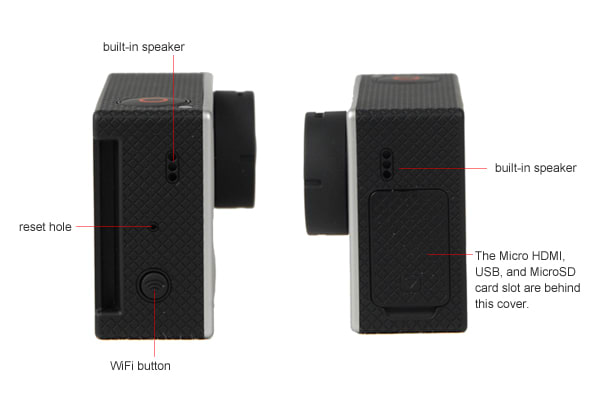
Right
{{section_header}}{{section.name}}{{/section_header}}
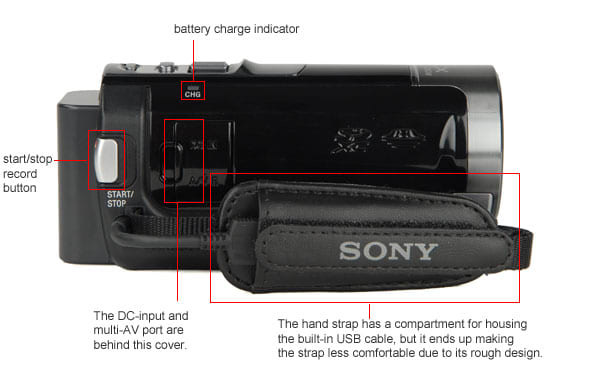
Top
{{section_header}}{{section.name}}{{/section_header}}

Bottom
{{section_header}}{{section.name}}{{/section_header}}

In the Box
{{section_header}}{{section.name}}{{/section_header}}

Color
{{section_header}}{{section.name}}{{/section_header}}
The Sony Bloggie Touch performed well in our color accuracy test, which is noteworthy for an ultracompact camcorders. Many similar models—like the Kodak Playsport and the Flip series of camcorders—struggle mightily with this test due to their poor auto white balance systems. The Bloggie Touch did run into this problem at times, but for the most part it was able to produce accurate colors in our bright light test, hence its strong score. More on how we test color.
In camcorders that struggle with white balancing properly, we often see orange or red hues associated with our bright light test image. You can see this in the color comparison table below with the comparison models. The sample image from the Bloggie Touch, however, looks quite good. According to our color error map, the Bloggie Touch did very well rendering brown and certain blue tones, while it had more trouble with green, yellow, and purple colors.
The Sony Bloggie Touch MHS-TS10 definitely had one of the best color accuracies we've seen from an ultracompact camcorder. This is just based on our testing, of course, and results do vary quite a bit depending on what kind of lighting you shoot under. Outdoors, under natural light, most ultracompact models produce fine colors. It is when you're inside, with mixed lighting, that you'll see problems like what we saw from the Flip SlideHD, Kodak Playsport, and to a lesser extent the Sony Bloggie MHS-CM5 as well.
{{comparison_bars title="Color Score Comparison", attribute="Color Score", xLabel="Color Score"}}
Low Light Color
{{section_header}}{{section.name}}{{/section_header}}
As is usually the case, the Bloggie Touch showed a significant drop in color accuracy when we dimmed the lights for our low light testing (compared to its bright light results). Still, the Bloggie Touch did a decent job in this test overall, although the other camcorders we compared it to had marginally better numbers. More on how we test low light color.
One thing you should notice from the comparison images below is how much brighter the Bloggie Touch's image is than the Kodak Playsport and even the Sony Bloggie MHS-CM5. Yes, the Flip SlideHD also produced a bright image in this test, and it managed an excellent saturation level of roughly 100%. We'd like the Bloggie Touch to have captured deeper colors in low light, and we noticed the saturation level dropping even further during our sensitivity test (when the lighting was minimal), but we're still adequately pleased with the camcorder's results here.
Noise
{{section_header}}{{section.name}}{{/section_header}}
Continuing its strong performance in our bright light testing, the Sony Bloggie Touch managed some very good results in our noise test. The camcorder averaged 0.5% noise, which is less noise than we saw on its predecessor, the Sony Bloggie MHS-CM5. This is a strong overall score, and only the Flip SlideHD measured less noise out of the camcorders shown below. More on how we test noise.
The Bloggie Touch records 1080p Full HD video, but its recorded image didn't appear any sharper than the competition. In fact, when you look at the crops above, you'll see the Bloggie Touch has a less crisp image than its predecessor, the Sony Bloggie MHS-CM5. We chalk this discrepancy up to the fact that the CM5 has a better lens (with optical zoom) than the Bloggie Touch, which can help produce a sharper image.
{{comparison_bars title="Noise Score Comparison", attribute="Noise Score", xLabel="Noise Score"}}
Low Light Sensitivity
{{section_header}}{{section.name}}{{/section_header}}
The Bloggie Touch did a decent job in our three low light tests, but we usually find ultracompact camcorders excel in low light because of their large sensors, fast lenses, and use of slow shutter speeds (that cannot be turned off). Even though the numbers may make it seem like these ultracompact models are better in low light than some high-end camcorders out there, they aren't really... but they are surprisingly good. More on how we test low light sensitivity.
The Bloggie Touch MHS-TS10 managed essentially the same low light sensitivity as its predecessor, the Sony Bloggie MHS-CM5. As we said in the paragraph above, the Bloggie Touch uses a slow shutter (1/30 of a second) in certain low light situations to boost performance. This feature cannot be turned off—as is the case for most ultracompacts—so we had to leave it on in our testing.
{{comparison_bars title="Low Light Sensitivity Comparison", attribute="Low Light Sensitivity Score", xLabel="Low Light Sensitivity Score"}}
Low Light Noise
{{section_header}}{{section.name}}{{/section_header}}
The Bloggie Touch had its finest performance in our low light noise test, with the camcorder producing just 0.5675% noise. This is less noise than we usually see from ultracompact camcorders, and it is less than we measured on last year's Bloggie MHS-CM5 from Sony.`` More on how we test low light noise.
You can see from the crop above that the Bloggie Touch produced a clean image in low light, although there was some discoloration present. It definitely retained some of the sharpest images we've seen from ultracompact camcorders in low light, and it strongly exceeded the Flip SlideHD and Kodak Playsport in that category. You can see some interference, however, on the horizontal trumpet in the crop above. Notice how the straight lines run a bit askew with jagged edges. This is very common and you can see this same problem on the CM5 and SlideHD.
{{comparison_bars title="Low Light Noise Score Comparison", attribute="Low Light Noise Score", xLabel="Low Light Noise Score"}}
Low Light Color
{{section_header}}{{section.name}}{{/section_header}}
As is usually the case, the Bloggie Touch showed a significant drop in color accuracy when we dimmed the lights for our low light testing (compared to its bright light results). Still, the Bloggie Touch did a decent job in this test overall, although the other camcorders we compared it to had marginally better numbers. More on how we test low light color.
One thing you should notice from the comparison images below is how much brighter the Bloggie Touch's image is than the Kodak Playsport and even the Sony Bloggie MHS-CM5. Yes, the Flip SlideHD also produced a bright image in this test, and it managed an excellent saturation level of roughly 100%. We'd like the Bloggie Touch to have captured deeper colors in low light, and we noticed the saturation level dropping even further during our sensitivity test (when the lighting was minimal), but we're still adequately pleased with the camcorder's results here.
Motion
{{section_header}}{{section.name}}{{/section_header}}
The Bloggie Touch can record video using a 30p or 60p frame rate, although to record at 60p you must use the 1280 x 720 record mode (Full HD is only available at 1080/30p). In our test video, the camcorder did a good job keeping artifacting to a minimum and producing a crisp image. When we looked closely, we did see some artifacting in the waterfall portion of our test, but it wasn't too noticeable. The video in the camcorder's 1080/30p mode was also choppier than we'd hoped it would be, but the 720/60p setting produce very smooth video. More on how we test motion.
Video Sharpness
{{section_header}}{{section.name}}{{/section_header}}
The Sony Bloggie Touch MHS-TS10 can record Full HD video, but that didn't translate into a top-notch performance in our video sharpness test. The Bloggie Touch managed a horizontal and vertical sharpness of 600 lw/ph each, which is a bit lower than the sharpness levels we measured from the competition (other than the Flip SlideHD, which only records 1280 x 720 video). Even so, this performance from the Bloggie Touch isn't terrible—we just expected better from the camcorder. More on how we test video sharpness.
{{comparison_bars title="Video Sharpness Score Comparison", attribute="Video Sharpness Score", xLabel="Video Sharpness Score"}}
Stabilization
{{section_header}}{{section.name}}{{/section_header}}
The Bloggie Touch is equipped with an image stabilization system, but the feature cannot be turned off manually. This means we were unable to test it using our shake-rig setup (if we can't turn stabilization off, then there's no way to see how much the camcorder "improves" the shake when the feature is engaged). From what we can tell, the stabilization uses a digital technology. More on how we test stabilization.
Testing Samples
{{section_header}}{{section.name}}{{/section_header}}
Usability
Ease of Use
{{section_header}}{{section.name}}{{/section_header}}
By some accounts, the Sony Bloggie Touch is a very simple camcorder. You don't have to worry about inserting memory cards because there is no memory card slot and the camcorder's touchscreen interface is very intuitive. The Bloggie Touch is not as simple as a Flip camcorder, mainly because it does have multiple recording options as well as a still image mode.
But what really makes the Bloggie Touch a bit confusing is the camcorder's ability to record horizontally or vertically. Let's be clear: we like this feature... it's just that we think it makes the Bloggie Touch more complicated. When you rotate the camcorder the LCD will automatically detect whether you are holding the Bloggie Touch vertically or horizontally and it will adjust the way it records to fit this position. Your video will always take up the entirety of the 3-inch LCD, which means when you record vertically your clips will have big black bars on either side when you view the clips on a television or a computer. Holding the Bloggie Touch horizontally, however, allows you to record with a standard widescreen aspect ratio (16:9) that should fit the screen of your HDTV perfectly during playback.
Yes, we know this is a bit confusing, but we like it more than the alternative and we think users will get the hang of it quickly. You just have to decide which way you like holding the camcorder and what you want your videos to look like when you play them back (on a TV, computer, or the Bloggie Touch itself). Other than this unique interface, the Bloggie Touch should be easy for most users to figure out and work with.
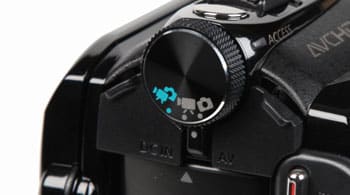
Auto Mode is confusingly called Dual Shot mode
Auto Mode
{{section_header}}{{section.name}}{{/section_header}}
Unlike most ultracompact models, the Bloggie Touch does have a simple autofocus mechanism. This autofocus is essentially an auto macro detection that allows you to focus on subjects as close as four inches away. Unfortunately, this focus system does not work quickly on the camcorder, and we noticed certain occasions where the Bloggie Touch would get "stuck" in macro focus for roughly five or six seconds while we were trying to shoot a regular shot. This is a disappointment because we like the camcorder's ability to record close subjects, but we don't want the focus switch to take any longer than a second or two.
Auto exposure on the Touch worked far quicker and we liked it. Exposure was adjusted with accuracy and the transition between light and dark scenes looked smooth and good. White balance worked well for the most part, but we did occasionally see the Bloggie Touch have some trouble under mixed indoor lights. This was particularly noticeable during focus adjustments, as we'd see the image turn a slight orange hue for a moment while the camcorder adjusted. There is face detection on the Bloggie Touch, but the system isn't nearly as effective as it is on a normal consumer camcorder.
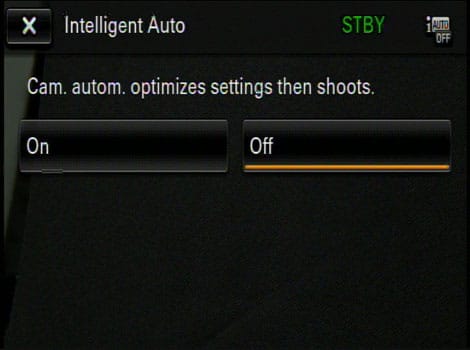
The iAuto mode button is difficult to find, but when you do find it the option for turning on the mode looks like this.
Auto Controls
{{section_header}}{{section.name}}{{/section_header}}
Focus - There's no manual focus adjustment option on the Bloggie Touch, but the camcorder does have a slight autofocus mechanism. Considering that most ultracompact models feature fixed lenses, the fact that the Bloggie Touch offers a small amount of autofocus is rather unique.
Exposure - The Bloggie Touch is a basic ultracompact camcorder, so it doesn't even have a manual exposure adjustment option.
Aperture - The Bloggie Touch has no manual aperture options either and the lens has a widest aperture setting of f/2.8.
Shutter Speed - Shutter speed is fully automated on the Bloggie Touch. According to Sony, the camcorder has a range of shutter speeds from 1/30 to 1/4000 of a second.
White Balance - Like aperture and shutter speed, the Bloggie Touch has a fully automated white balance system—with no manual options or presets.
Gain - Gain control is fully automated on the Bloggie Touch.
Color & Image Controls - There's no special color or image controls on the Bloggie Touch. All you can really adjust is the record mode and the photo size.
Handling
{{section_header}}{{section.name}}{{/section_header}}
Touchscreens on camcorders isn't a new technology, but the way Sony implements the feature on the Bloggie Touch is fairly unique. As we discussed above, the auto rotate feature of the LCD can be confusing at first—and we wish Sony would include an option for turning it off—but it does allow you to use the entire LCD during recording, which we think is great. As for the touchscreen itself, sometimes we found it to be unresponsive, but it wasn't any worse than the touchscreens we're used to seeing on consumer camcorders.

Aesthetically, the Bloggie Touch is a stylish ultracompact camcorder that feels solid and durable in your hand. The camcorder can stand on its own, a rarity for ultracompact models, but it doesn't have the best balance due to its ultra-thin design. We recommend holding the Bloggie Touch MHS-TS10 horizontally during video recording if possible. Trust us, you're videos will look much better if you do things this way. When you watch them on an HDTV or upload them to YouTube, your videos will retain that great widescreen format that fills the whole screen. Shooting vertically will result in skinny, tall videos with big black bars on both sides (unless you view the clips on the camcorder itself).

Holding the Bloggie Touch horizontally may feel awkward, but it is similar to using a very thin digital camera. The shutter and power button is even located on the top there, so we think Sony had this design in mind when they made the Bloggie Touch. Strangely, the camcorder's main menu will only list vertically (it doesn't automatically "rotate" when you turn the camcorder on its side), but that's not too much of an issue.

The Bloggie Touch is a bit slippery and doesn't have much of a grip, so you should probably connect the wrist strap to its base if you can. We like the design of the camcorder's built-in USB arm as well, and we found it to be more durable than the switch-release system you see on Flip camcorders.

These dedicated buttons give you quick access to aperture and shutter speed controls.
Portability
{{section_header}}{{section.name}}{{/section_header}}
With the Bloggie Touch, Sony decided to mimic the simple, streamline design that Flip has utilized on its ultracompact camcorders for a few years now. The Touch has no memory card slot, no removable battery, and only has three physical buttons. All these factors enable the Bloggie Touch to be a whole lot lighter and thinner than Sony's previous Bloggie MHS-CM5, although the CM5 did have a much better lens with a 5x optical zoom (which added to the camcorder's weight and bulk).
Anyway, the point is, the Bloggie Touch is thin, compact, and a tad smaller than an iPhone or iPod Touch. The fact that it only contains 4GB of internal memory (or 8GB on the more expensive model, the MHS-TS20) is a bit disappointing as far as portability is concerned. If you shoot a lot of video you'll definitely need to dump your clips off to a computer or hard drive frequently if you don't want to worry about running out of recording space. This is where the versatility of a memory card slot gives you a strong advantage.
Battery Life
{{section_header}}{{section.name}}{{/section_header}}
The MHS-TS10 Bloggie Touch lasted for 113 minutes in our battery life test, which is a strong showing for a camcorder of its class. However, before we give lots of praise to the camcorder's battery pack, we must reiterate that the Bloggie Touch has an internal, non-removable battery. Whether or not this is a downside depends on how you'd like to use your camcorder. Having an internal battery does make the Bloggie Touch simpler, and it eliminates one more component that can't get lost or damaged. But, it also means you can't purchase backup battery packs to insert when your first one dies. For comparison, the Kodak Playsport and the Sony Bloggie MHS-CM5 both have removable battery packs, while the Flip SlideHD has an internal battery like the Bloggie Touch. More on how we test battery life.

{{comparison_bars title="Battery Life Comparison", attribute="Battery Life Score", xLabel="minutes"}}
LCD
{{section_header}}{{section.name}}{{/section_header}}
The Sony Bloggie Touch has the best LCD we've seen on an ultracompact camcorder so far. At three inches in size, the screen is as big as what you get on the Flip SlideHD, but it has a far better resolution and its touchscreen design is much more precise. What really bugged us about the LCD on the SlideHD was the fact that only a fraction of the large screen was usable during video recording (2/3 of the screen was taken up by touchscreen buttons). The Bloggie Touch, however, makes use of the entire screen in both playback and record mode—and it lets your video fill the screen whether you shoot vertically or horizontally with the camcorder.
Some people may be confused by the rotation detection on the LCD with the Bloggie Touch, and we must admit, it can be a bit strange. When you shoot video holding the camcorder horizontally, the screen displays a frame as such with a 16:9 display (normal for a camcorder). When you hold the device vertically, however, the image also fills the screen, which means your recorded video comes out having huge black bars on the left and right when you view it on a computer or television. Yes, it is awkward, yes it will confuse beginners, but we think this concept should make sense to people after a few uses... and they'll begin to hold the Bloggie Touch in the manner they feel is most suitable to their shooting needs.
Stabilization
{{section_header}}{{section.name}}{{/section_header}}
The Bloggie Touch is equipped with an image stabilization system, but the feature cannot be turned off manually. This means we were unable to test it using our shake-rig setup (if we can't turn stabilization off, then there's no way to see how much the camcorder "improves" the shake when the feature is engaged). From what we can tell, the stabilization uses a digital technology. More on how we test stabilization.
Manual Focus
{{section_header}}{{section.name}}{{/section_header}}
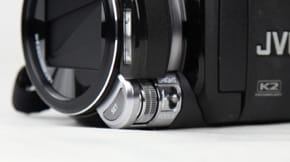
The adjustment dial makes accurate focus adjustments easy.
Manual Exposure
{{section_header}}{{section.name}}{{/section_header}}
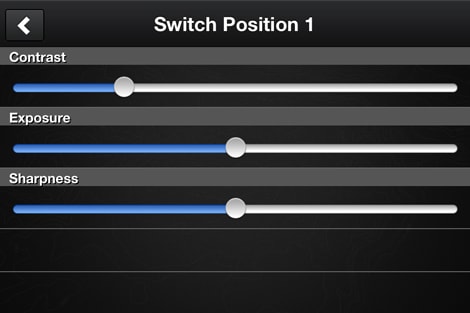
The manual exposure controls are only found on the Contour app, not on the camcorder itself.
Miscellaneous Controls
{{section_header}}{{section.name}}{{/section_header}}
Sony tried hard to keep things simple on the Bloggie Touch, as there are no extra manual controls on the camcorder.
Auto Controls
{{section_header}}{{section.name}}{{/section_header}}
Focus - There's no manual focus adjustment option on the Bloggie Touch, but the camcorder does have a slight autofocus mechanism. Considering that most ultracompact models feature fixed lenses, the fact that the Bloggie Touch offers a small amount of autofocus is rather unique.
Exposure - The Bloggie Touch is a basic ultracompact camcorder, so it doesn't even have a manual exposure adjustment option.
Aperture - The Bloggie Touch has no manual aperture options either and the lens has a widest aperture setting of f/2.8.
Shutter Speed - Shutter speed is fully automated on the Bloggie Touch. According to Sony, the camcorder has a range of shutter speeds from 1/30 to 1/4000 of a second.
White Balance - Like aperture and shutter speed, the Bloggie Touch has a fully automated white balance system—with no manual options or presets.
Gain - Gain control is fully automated on the Bloggie Touch.
Color & Image Controls - There's no special color or image controls on the Bloggie Touch. All you can really adjust is the record mode and the photo size.
Audio Controls
{{section_header}}{{section.name}}{{/section_header}}
The Bloggie Touch has so little in the way of audio features that we almost considered eliminating this section of our review. Since it is here, we should probably talk about the camcorder's built in microphone, which is stupidly located on the right side of the camcorder(or top, depending how you hold it) . We hate this mic position because you can easily cover or rub it with your finger if you aren't paying attention. Not that this matters all that much—the Bloggie Touch records fairly lousy mono audio even if the mic is completely unobstructed.
Editing
{{section_header}}{{section.name}}{{/section_header}}
Like most ultracompact camcorders, the Bloggie Touch ships with built-in software that you can install by connecting the camcorder directly to a computer. Sony says this built-in "Bloggie Software" will be compatible with Macs, but as of November 2010, the company has yet to release an update to make the software Mac-compatible.
The Bloggie Software loaded on the Bloggie Touch is different than what you get on Sony's previous generation of Bloggie camcorders, but there are some similarities. The most exciting addition is a new Personal Space feature. Personal Space is a Sony-owned website where you can store your videos and photos and share them with friends. Registering on the site is free and it comes with 1GB of "personal space" for you to store your content (hence the name). For an overview of the software that ships with this and other camcorders, see our article: Video Editing Software For Your Camcorder{{product.brand.name}}-Included-Software.htm.
Compression
{{section_header}}{{section.name}}{{/section_header}}
Like most ultracompacts, the Sony Bloggie Touch MHS-TS10 records HD video using the MPEG-4 codec. The videos are far easier to work with and upload to the internet than AVCHD clips, as they can be easily dragged right from the camcorder's internal memory onto your computer desktop. Read more about the advantages and disadvantages of MPEG-4.
The camcorder has three quality options, including one Full HD setting (1080/60p) and two 720/60p HD modes. There are no standard definition record modes available on the camcorder. Read more about the advantages and disadvantages of various high definition compression types.
Media
{{section_header}}{{section.name}}{{/section_header}}
Instead of including a memory card slot on the Bloggie Touch, Sony decided to simplify its new ultracompact camcorders by including internal flash memory only... just like Flip camcorders have been doing since their incarnation. The Bloggie Touch is available in two sizes, 4GB or 8GB, and the model we reviewed was the 4GB version (the MHS-TS10 is its official name). Read more about the advantages and disadvantages of flash memory.
We like how having no memory card slot simplifies things, but it can be a nuisance for people who, a) have a lot of unused memory cards lying around, or, b) record so much video that the 4GB of internal memory isn't enough. Is 4GB of internal memory enough space for you or will you need to upgrade to the 8GB MHS-TS20 Bloggie Touch model? Check out our handy table to find the approximate record times those 4GB will get you with the Bloggie Touch—then you can make an informed decision. Read more about the advantages and disadvantages of various media types.

Slow Motion Modes
Still Features
{{section_header}}{{section.name}}{{/section_header}}
The Sony Bloggie Touch takes good still photos. That's quite a compliment considering the fact that many ultracompact camcorders don't even take still photos at all (like the Flip series of camcorders). The Touch can capture native 12-megapixel still images at a 4128 x 3096 resolution, and it also has 8-megapixel and 2-megapixel photo options (both of which capture at a 16:9 aspect ratio).
The camcorder also has the ability to snap photos during video recording, which is something that is not available on many ultracompact camcorders (the Kodak Playsport and the Sony MHS-CM5 can't do this). Finally, there's a basic self-timer on the Bloggie Touch as well.
The Bloggie Touch disappointed in our still color test, mainly because the camcorder didn't produce colors that were nearly as accurate as we saw in our video testing. However, the camcorder still did a better job than the competition here, so we were pleased on that front.
Compared to the Kodak Playsport and the Sony Bloggie MHS-CM5, the Bloggie Touch produced still images that were much cleaner and had more accurate colors.
Noise levels on the still images captured by the Bloggie Touch were too high for our standards. The camcorder managed a noise level of around 1.04% in this test, which is twice as much as the Kodak Playsport averaged. This result isn't all that bad, however, because we often see worse numbers in this test (as noted by the MHS-CM5's dismal noise percentage of 1.77%).
With its 12-megapixel still image capability, we weren't that surprised to see the Bloggie Touch master our still sharpness test. the camcorder captured some of the sharpest still images we've seen from an ultracompact model: 2327 lw/ph horizontal with 44.5% oversharpening and 2306 lw/ph vertical with 33.5% oversharpening. These oversharpening values are definitely high, but we're fine with overlooking that fact when the camcorder can deliver such sharp still images.
Lens & Imaging System
{{section_header}}{{section.name}}{{/section_header}}

The lens on the Bloggie Touch is tiny, but it is easy to find on the front of the camcorder. We don't want to say the lens is fixed and has no moving parts because we aren't sure—there's definitely an autofocus system on the camcorder, so something is adjusting the lens even if it is ever-so-slightly. Still, Sony doesn't list a focal or aperture range for the camcorder, but instead says the minimum focus distance for the Bloggie Touch is four inches (10cm). Four inches is actually very good for a minimum focus distance on an ultracompact model, as we've seen many camcorders struggle with focusing on close subjects. For comparison, the Kodak Playsport has a minimum focus distance of around five feet (150m).
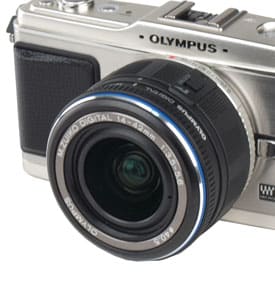
LCD
{{section_header}}{{section.name}}{{/section_header}}
The Sony Bloggie Touch has the best LCD we've seen on an ultracompact camcorder so far. At three inches in size, the screen is as big as what you get on the Flip SlideHD, but it has a far better resolution and its touchscreen design is much more precise. What really bugged us about the LCD on the SlideHD was the fact that only a fraction of the large screen was usable during video recording (2/3 of the screen was taken up by touchscreen buttons). The Bloggie Touch, however, makes use of the entire screen in both playback and record mode—and it lets your video fill the screen whether you shoot vertically or horizontally with the camcorder.
Some people may be confused by the rotation detection on the LCD with the Bloggie Touch, and we must admit, it can be a bit strange. When you shoot video holding the camcorder horizontally, the screen displays a frame as such with a 16:9 display (normal for a camcorder). When you hold the device vertically, however, the image also fills the screen, which means your recorded video comes out having huge black bars on the left and right when you view it on a computer or television. Yes, it is awkward, yes it will confuse beginners, but we think this concept should make sense to people after a few uses... and they'll begin to hold the Bloggie Touch in the manner they feel is most suitable to their shooting needs.
Connectivity
{{section_header}}{{section.name}}{{/section_header}}
There's not much to talk about as far as connectivity features go on the Bloggie Touch MHS-TS10. The camcorder has just two terminals: a built-in USB arm and an HDMI port. Let's start with the USB arm, which is located on the bottom of the Bloggie Touch and is clearly designed with the Flip camcorders in mind. The difference with the Bloggie Touch, however, is that the USB arm does not release via a switch or lock. Instead, you push on the edge of the arm and the USB port flips out. You tuck the arm back into the camcorder in the same manner. We like this setup because we think it is harder to break than the button-release system you see on Flip camcorders (still, it is more fragile than a regular USB terminal would be).
Since the USB arm doesn't extend out from the Bloggie Touch very far, Sony kindly ships a small USB extender with the camcorder. The extender is only five or six inches long, but it should get the job done for most camcorder-to-computer connections. Remember, though, the Bloggie Touch doesn't have a DC-input, so you must charge it via USB. And that's an area where the little extender cable comes in handy.
Take a gander of the thin left side of the Bloggie Touch and you'll find a tiny flip-down door that houses the HDMI input. The port is tiny, and its cover isn't reliably strong, but we like the placement of the input as its position allows it to blend into the streamlined design of the camcorder. Unfortunately, the Bloggie Touch has no other video-output ports other than HDMI, so you're out of luck if want to hook up the camcorder to a standard definition TV.
Media
{{section_header}}{{section.name}}{{/section_header}}
Instead of including a memory card slot on the Bloggie Touch, Sony decided to simplify its new ultracompact camcorders by including internal flash memory only... just like Flip camcorders have been doing since their incarnation. The Bloggie Touch is available in two sizes, 4GB or 8GB, and the model we reviewed was the 4GB version (the MHS-TS10 is its official name). Read more about the advantages and disadvantages of flash memory.
We like how having no memory card slot simplifies things, but it can be a nuisance for people who, a) have a lot of unused memory cards lying around, or, b) record so much video that the 4GB of internal memory isn't enough. Is 4GB of internal memory enough space for you or will you need to upgrade to the 8GB MHS-TS20 Bloggie Touch model? Check out our handy table to find the approximate record times those 4GB will get you with the Bloggie Touch—then you can make an informed decision. Read more about the advantages and disadvantages of various media types.

Still Features
{{section_header}}{{section.name}}{{/section_header}}
The Sony Bloggie Touch takes good still photos. That's quite a compliment considering the fact that many ultracompact camcorders don't even take still photos at all (like the Flip series of camcorders). The Touch can capture native 12-megapixel still images at a 4128 x 3096 resolution, and it also has 8-megapixel and 2-megapixel photo options (both of which capture at a 16:9 aspect ratio).
The camcorder also has the ability to snap photos during video recording, which is something that is not available on many ultracompact camcorders (the Kodak Playsport and the Sony MHS-CM5 can't do this). Finally, there's a basic self-timer on the Bloggie Touch as well.
The Bloggie Touch disappointed in our still color test, mainly because the camcorder didn't produce colors that were nearly as accurate as we saw in our video testing. However, the camcorder still did a better job than the competition here, so we were pleased on that front.
Compared to the Kodak Playsport and the Sony Bloggie MHS-CM5, the Bloggie Touch produced still images that were much cleaner and had more accurate colors.
Noise levels on the still images captured by the Bloggie Touch were too high for our standards. The camcorder managed a noise level of around 1.04% in this test, which is twice as much as the Kodak Playsport averaged. This result isn't all that bad, however, because we often see worse numbers in this test (as noted by the MHS-CM5's dismal noise percentage of 1.77%).
With its 12-megapixel still image capability, we weren't that surprised to see the Bloggie Touch master our still sharpness test. the camcorder captured some of the sharpest still images we've seen from an ultracompact model: 2327 lw/ph horizontal with 44.5% oversharpening and 2306 lw/ph vertical with 33.5% oversharpening. These oversharpening values are definitely high, but we're fine with overlooking that fact when the camcorder can deliver such sharp still images.
Other Features
{{section_header}}{{section.name}}{{/section_header}}
HDMI Output 50Hz or 60Hz
This is essentially a PAL output option, which is a common feature on ultracompact camcorders. Switching the HDMI output to 50Hz allows you to send a video signal to a PAL format television (the NTSC default is 60 Hz). Not the most impressive feature, but it can be useful if you travel overseas frequently.
Sony MHS-CM5 Comparison
In many ways, the Kodak Playsport is the opposite of the Bloggie Touch. The Kodak features a utilitarian design that is both waterproof (up to 10 feet) and rugged, but it doesn't have the sleek, stylish look that you get with the Bloggie Touch. The Playsport is also more versatile with its removable battery and memory card slot that accepts SD/SDHC memory cards. The Playsport is a bit thicker and heavier than the Bloggie Touch, but the size of the two camcorders isn't all that different.
The big advantage of the Bloggie Touch is its 3-inch LCD, which is the best screen we've seen on an ultracompact camcorder. We also think the all-inclusive nature of the Bloggie Touch, with its internal battery and flash memory, makes it an easier camcorder to use than the Playsport (but it's also far less adaptable for multiple shooting situations).
Both of these camcorders are very good ultracompact models, but we like the Kodak Playsport more—especially if you don't care much about the style or look of your gadgets. To top it off, the Kodak Playsport is a bit cheaper than the Bloggie Touch MHS-TS10, which makes it a better buy if you're trying to keep your costs down.
Pure Digital Flip SlideHD Comparison
The MHS-CM5 is one of Sony's original Bloggie camcorders. The Bloggie Touch isn't meant to replace the MHS-CM5, however, as both models are still available in stores. Instead, the Bloggie Touch is seen as a higher-end version of the original Bloggie MHS-CM5. The thing is, there are a number of things that make the MHS-CM5 better than the Bloggie Touch. It has a 5x optical zoom, it did better in some of our testing, and it uses a memory card slot instead of just having internal memory. It also has more recording modes (including a standard definition recording option).
The Bloggie MHS-CM5 is also a whole lot larger than the Bloggie Touch, and it doesn't feature the touchscreen interface (which is why it lacks the "Touch" surname). It also isn't nearly as stylish or fun, and its construction feels a bit cheap. Both camcorders are simple to use, but we like the controls on the Bloggie Touch more and we think most people will be comfortable with the touchscreen interface.
Overall, we like the updates Sony made to their Bloggie lineup with the new Touch MHS-TS10. Instead of simply adding new features or making slight alterations, Sony completely rethought their idea of what an ultracompact camcorder should be. As a result, the Bloggie Touch has an entirely different look and user experience than the MHS-CM5 and Sony's previous Bloggie models.
COMP 3
The SlideHD is the first Flip camcorder to feature a touchscreen LCD. Just like the Bloggie Touch, the screen on the SlideHD is 3-inches in size, but when it comes to usability in video mode the screen is downright awful. The entirety of the screen can only be used in playback mode, and when you're recording video only a tiny portion of the screen contains the video frame (roughly 1.5 or 2 inches). The rest of the touchscreen is taken up by large touch sensitive buttons that appear on the screen when you're in record mode on the SlideHD. This interface isn't well thought out and it pales in comparison to the full-screen system in place on the Bloggie Touch.
With a price tag of $100 more than the Bloggie Touch, the SlideHD is very expensive for an ultracompact model. The SlideHD does, however, contain 16GB of internal flash memory, so you do have to take that into account when you consider its price. The real downer that we can't overlook about the SlideHD is the fact that it—and all Flip camcorders—only record at a 1280 x 720 resolution. It does not record Full HD like the Bloggie Touch, and it struggled in our sharpness test as a result.
We normally like Flip camcorders for their simplicity, but the SlideHD was one of the most disappointing models of the 2010 lineup. Instead of improving design and performance, the Flip SlideHD is actually a worse camcorder than its predecessors. The touchscreen LCD is gimmicky, designed poorly, and doesn't mesh well with the interface in video mode. Sony gets the touchscreen system down much better on the Bloggie Touch, and we're hoping Flip is taking notes so they can improve.
Conclusion
The Sony Bloggie Touch isn't just an update of Sony's previous ultracompact models—it's an entirely new kind of camcorder. With its 3-inch touchscreen and stylish design, the Sony Bloggie Touch MHS-TS10 offers a completely different user experience than last year's Bloggie MHS-CM5 and MHS-PM5 from Sony.
The new design of the Bloggie Touch offers a simpler interface, a far more sophisticated appearance, and makes for a better camcorder overall. The Bloggie Touch definitely has its problems (most ultracompacts do), but the camcorder does a good job where it counts. The built-in editing software is Sony's simplest version to date, and it allows you to easily share videos with friends on YouTube, Facebook, or Sony's own "Personal Space" online storage system.
In designing the Bloggie Touch, Sony borrowed heavily from the Flip line of ultracompact camcorders, particularly the Flip SlideHD. However, Sony made many improvements where the Flip SlideHD failed. These improvement ts include a thinner design, a more effective LCD, and an auto screen rotation feature that allows you to record video while holding the camcorder horizontally or vertically. The Sony Bloggie Touch also did well in most of our video tests, although we were a bit disappointed by its lackluster sharpness scores.
We're happy to see Sony invigorate the ultracompact market with something new and fresh like the Bloggie Touch. Hopefully, other manufacturers will follow suit with their own unique designs that bring new ideas to this burgeoning field. The Bloggie Touch is available in to versions: the 4GB MHS-TS10 (shown throughout this review) and the 8GB MHS-TS20.
Photo Gallery
{{photo_gallery "Front Photo", "Left Photo", "Left Open Photo", "Back Photo", "Right Photo", "Top Photo", "Bottom Photo", "Lens Photo", "Lens Photo 2", "3D Lens Photo", "Media Photo", "Easy Mode Photo", "Manual Controls Photo", "Zoom Photo", "Zoom Photo 2", "Ease of Use Photo", "Battery Photo", "LCD Photo 1", "LCD Photo 2", "EVF Photo 1", "EVF Photo 2", "Mic Photo", "Mic Photo 2", "Ports Photo 1", "Ports Photo 2", "Ports Photo 3", "Ports Photo 4", "Ports Photo 5", "Ports Photo 6", "Handling Photo 1", "Handling Photo 2", "Handling Photo 3", "Handling Photo 4", "Box Photo"}}
Meet the tester
Jeremy is the video expert of our imaging team and Reviewed.com's head of video production. Originally from Pennsylvania and upstate NY, he graduated from Bard college with a degree in film and electronic media. He has been living and working in New England since 2005.
Checking our work.
Our team is here to help you buy the best stuff and love what you own. Our writers, editors, and experts obsess over the products we cover to make sure you're confident and satisfied. Have a different opinion about something we recommend? Email us and we'll compare notes.
Shoot us an email